Sony RM-U306, STR-DE585 User Manual
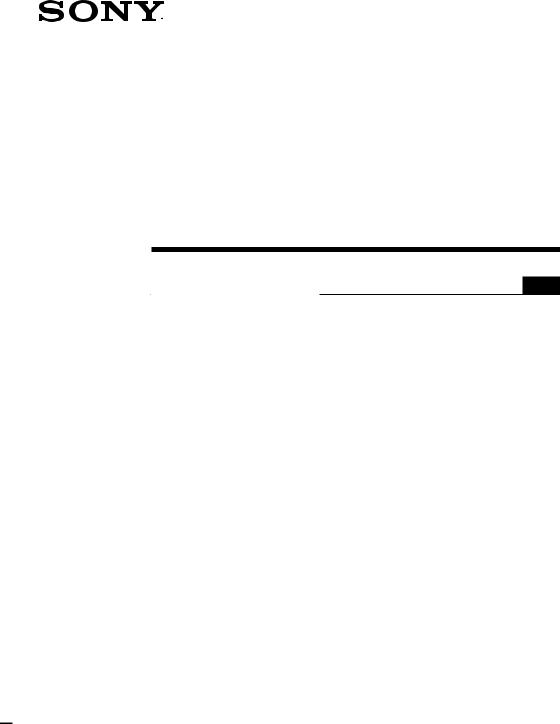
4-238-375-13(1)
FM Stereo
FM-AM Receiver
Operating Instructions |
GB |
Owner’s Record
The model and serial numbers are located on the rear panel. Record the serial number in the space provided below. Refer to them whenever you call upon your Sony dealer regarding this product.
Model No. STR-DE585/DE485E/DE485 |
Serial No. |
|
STR-DE585
STR-DE485E
STR-DE485
© 2002 Sony Corporation
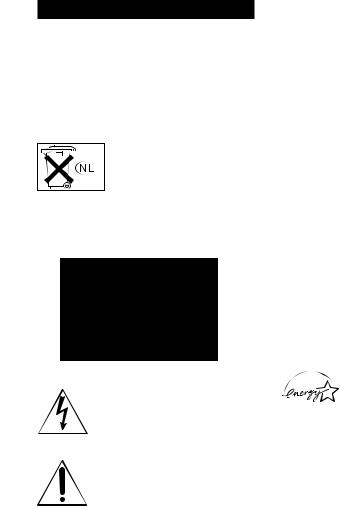
WARNING
To prevent fire or shock hazard, do not expose the unit to rain or moisture.
To prevent fire, do not cover the ventilation of the apparatus with newspapers, table-cloths, curtains, etc. And don’t place lighted candles on the apparatus.
To prevent fire or shock hazard, do not place objects filled with liquids, such as vases, on the apparatus.
Don’t throw away the battery with general house waste, dispose of it correctly as chemical waste.
Do not install the appliance in a confined space, such as a bookcase or built-in cabinet.
For customers in the United States
This symbol is intended to alert the user to the presence of uninsulated “dangerous voltage” within the product’s enclosure that may be of sufficient magnitude to constitute a risk of electric shock to persons.
This symbol is intended to alert the user to the presence of important operating and maintenance (servicing) instructions in the literature accompanying the appliance.
WARNING
This equipment has been tested and found to comply with the limits for a Class B digital device, pursuant to Part 15 of the FCC Rules. These limits are designed to provide reasonable protection against harmful interference in a residential installation. This equipment generates, uses, and can radiate radio frequency energy and, if not installed and used in accordance with the instructions, may cause harmful interference to radio communications. However, there is no guarantee that interference will not occur in a particular installation. If this equipment does cause harmful interference to radio or television reception, which can be determined by turning the equipment off and on, the user is encouraged to try to correct the interference by one or more of the following measures:
–Reorient or relocate the receiving antenna.
–Increase the separation between the equipment and receiver.
–Connect the equipment into an outlet on a circuit different from that to which the receiver is connected.
–Consult the dealer or an experienced radio/TV technician for help.
CAUTION
You are cautioned that any changes or modification not expressly approved in this manual could void your authority to operate this equipment.
Note to CATV system installer:
This reminder is provided to call CATV system installer’s attention to Article 820-40 of the NEC that provides guidelines for proper grounding and, in particular, specifies that the cable ground shall be connected to the grounding system of the building, as close to the point of cable entry as practical.
For customers in Canada
CAUTION
TO PREVENT ELECTRIC SHOCK, DO NOT USE THIS POLARIZED AC PLUG WITH AN EXTENSION CORD, RECEPTACLE OR OTHER OUTLET UNLESS THE BLADES CAN BE FULLY INSERTED TO PREVENT BLADE EXPOSURE.
ENERGY STAR® is a U.S. registered mark.
As an ENERGY STAR® partner, Sony Corporation has determined that this product meets the ENERGY STAR® guidelines for energy efficiency.
This receiver incorporates Dolby* Digital and Pro Logic Surround and the DTS** Digital Surround System.
*Manufactured under license from Dolby Laboratories.
“Dolby”, “Pro Logic” and the double-D symbol are trademarks of Dolby Laboratories.
**“DTS” and “DTS Digital Surround” are registered trademarks of Digital Theater Systems, Inc.
2GB
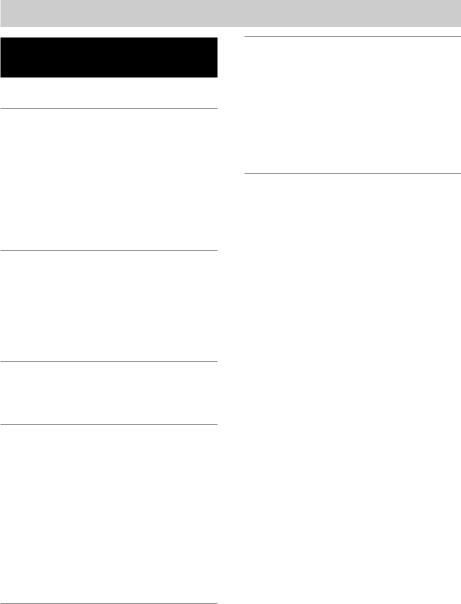
Table of Contents |
|
List of Button Locations and |
|
Reference Pages |
|
Main unit ............................................... |
5 |
Hooking Up the Components |
|
Required cords ....................................... |
6 |
Antenna hookups ................................... |
7 |
Audio component hookups .................... |
8 |
Video component hookups .................... |
9 |
Digital component hookups ................. |
10 |
Multi channel input hookups1) ............. |
11 |
Other hookups ..................................... |
12 |
Hooking Up and Setting Up |
|
the Speaker System |
|
Speaker system hookups ..................... |
13 |
Performing initial setup operations ..... |
15 |
Multi channel surround setup .............. |
15 |
Checking the connections .................... |
20 |
Basic Operations |
|
Selecting the component ..................... |
21 |
Changing the display ........................... |
22 |
Enjoying Surround Sound |
|
Automatically decoding the input |
|
audio signal ................................... |
23 |
Selecting a sound field ........................ |
23 |
Using only the front speakers |
|
(2 Channel Stereo) ......................... |
25 |
Enjoying stereo sound in multi channel |
|
(Dolby Pro Logic II) ...................... |
25 |
Understanding the multi channel |
|
surround displays .......................... |
26 |
Customizing sound fields .................... |
27 |
Receiving Broadcasts |
|
Storing FM stations automatically |
|
(AUTOBETICAL)2) ...................... |
30 |
Direct tuning ........................................ |
30 |
Automatic tuning ................................. |
31 |
Preset tuning ........................................ |
31 |
Using the Radio Data System (RDS)2) .... 33 |
|
Other Operations
Naming preset stations and program |
|
sources ........................................... |
35 |
Recording ............................................ |
35 |
Using the Sleep Timer ......................... |
36 |
Adjustments using the SET UP |
|
button ............................................ |
36 |
Operations Using the Remote
RM-PP5063)
Before you use your remote ................ |
38 |
|
|
Remote button description ................... |
38 |
|
|
Selecting the mode of the remote ........ |
41 |
|
|
Programming the remote |
42 |
|
|
|
GB |
||
|
|
|
|
|
|
|
|
Operations Using the Remote |
|
|
|
RM-U3064) |
|
|
|
Before you use your remote ................ |
45 |
|
|
Remote button description ................... |
45 |
|
|
Changing the factory setting of a |
|
|
|
function button .............................. |
48 |
|
|
|
|
|
|
Additional Information |
|
|
|
Precautions .......................................... |
49 |
|
|
Troubleshooting ................................... |
49 |
|
|
Specifications ...................................... |
52 |
|
|
Tables of settings using SURR, LEVEL, |
|
|
|
SET UP, BASS and TREBLE |
|
|
|
buttons ........................................... |
54 |
|
|
Adjustable parameters for each |
|
|
|
sound field ..................................... |
55 |
|
|
1)STR-DE585 and STR-DE485 only
2)Models of area code CEL, CEK only.
3)For STR-DE585 area code CA only.
4)Except for STR-DE585 area code CA.
3GB
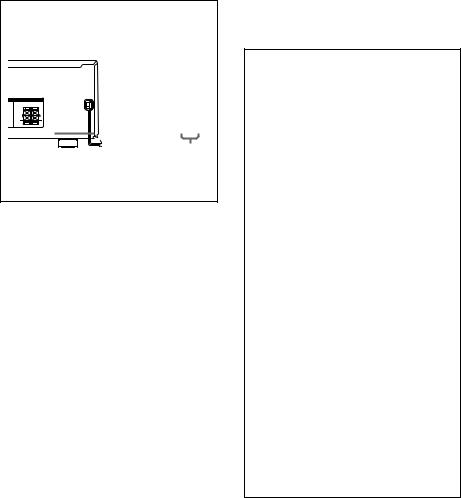
About This Manual
The instructions in this manual are for models STR-DE585, STR-DE485E and STR-DE485. Check your model number by looking at the lower right corner of the front panel. In this manual, the STR-DE585 is used for illustration purposes unless stated otherwise. Any difference in operation is clearly indicated in the text, for example, “STR-DE485E only”.
About area codes
The area code of the receiver you purchased is shown on the lower portion of the rear panel (see the illustration below).
IMPEDANCE USE 8 – 16Ω
TER |
FRONT |
R L
R L

 4-XXX-XXX-XX AA
4-XXX-XXX-XX AA
Area code
Any differences in operation, according to the area code, are clearly indicated in the text, for example, “Models of area code AA only”.
Tip
The instructions in this manual describe the controls on the receiver. You can also use the controls on the supplied remote if they have the same or similar names as those on the receiver. For details on the use of your remote, see
•pages 38-44 for RM-PP506 (STR-DE585 area code CA only)
•pages 45-48 for RM-U306 (except for STR-DE585 area code CA)
Note for the supplied remote
For RM-PP506 (STR-DE585 area code CA only)
The VIDEO 3, TV/SAT, AUX, PHONO, AUDIO SPLIT, NIGHT MODE, EQ/TONE, ON SCREEN, /10, /11, /12, 3RD, 2ND ROOM and SOURCE buttons on the remote are not available.
For RM-U306 (STR-DE485E only)
The MULTI CH button on the remote is not available.
Demonstration Mode
The demonstration will activate the first time you turn on the power. When the demonstration starts, the following message appears in the display:
“NOW DEMONSTRATION MODE IF YOU FINISH DEMONSTRATION PLEASE PRESS POWER KEY WHILE THIS MESSAGE APPEARS IN THE DISPLAY THANK YOU”
To cancel the demonstration
Press ?/1 to turn the receiver off while the above message is being displayed. The next time you turn the receiver on, the demonstration will not appear.
To view the demonstration
Hold down SET UP and press ?/1 to turn on the power.
Notes
•Running the demonstration will clear the receiver’s memory. For details on what will be cleared, see “Clearing the receiver's memory” on page 15.
•There will be no sound when the demonstration mode is activated.
•You cannot cancel demonstration if you did not press ?/1 while the above message is being displayed. To cancel demonstration after the above message appears, press ?/1 twice to activate the demonstration again. Then, press ?/1 while the above message is being displayed.
4GB
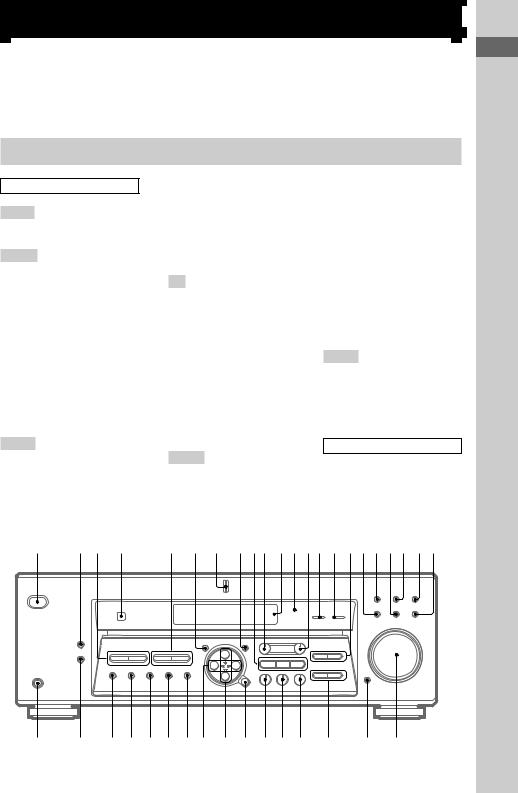
List of Button Locations and Reference Pages
|
Illustration number |
|
How to use this page |
|
r |
Use this page to find the location of buttons |
NAME |
8 (35) |
|
|
|
that are mentioned in the text. |
R |
R |
|
Name of button/part |
Reference page |
|
|
|
Main unit
ALPHABETICAL ORDER
0 – 9
2 CH wh (25)
A – D
A.DEC wk (23–25)
AM (Except for models of area code CEL, CEK) es (30, 31)
BASS +/– wg (29, 54) CD ql (21)
CINEMA STUDIO EX A, B, C 9 (23, 24)
Digital Cinema Sound (indicator) qs (23)
DIMMER ej (22) DISPLAY 2 (22, 33, 51) Display qa (22) DVD/LD wa (21)
E – L
ENTER wl (35)
FM (Except for models of area code CEL, CEK) ed (30, 31)
FM/AM (Models of area code CEL, CEK only) es (30, 31)
FM MODE (Models of area code CEL, CEK only) ed, (Except for models of area code CEL, CEK) ef (31)
INPUT MODE qg (21)
IR (receptor) 4 (38, 45, 51) LEVEL 0 (20, 27, 55)
M
MASTER VOLUME wd (20, 49) MD/TAPE qj (21)
MEMORY eh (30, 32) MENU +/– e; (16, 27, 35, 36) MENU </> ea (16, 27, 35, 36) MODE wj (24, 50)
MULTI CHANNEL DECODING (indicator) (Except for STR-DE485E) 7 (21)
MULTI CH IN (Except for STR-DE485E) qf (21)
MUTING wf (21, 49)
N – S
NAME 8 (35)
PHONES (jack) ek (21)
PRESET/PTY SELECT +/– (Models of area code CEL, CEK only) 3 (32, 33)
PRESET TUNING +/– (Except for models of area code CEL, CEK) 3 (32, 53)
PTY (Models of area code CEL, CEK only) ef (33)
SET UP 6 (4, 16, 36, 54) SHIFT eg (32)
SLEEP (STR-DE485E only)qf (36)
SURR qd (27, 54)
T – Z
TREBLE +/– qh (29, 54) TUNER ws (21, 30-32, 35) TUNING +/– 5 (31) VIDEO 1 qk (21)
VIDEO 2 w; (21)
BUTTON DESCRIPTIONS
`/1 (power) 1 (4, 15, 20, 29, 30, 53)
1 2 3 4 5 6 7 890qaqsqdqfqgqhqjqkqlw; waws
g
ek |
ej eh eg ef ed es ea e; wl wk wj wh wg |
wf wd |
of List Locations Button
Reference and Pages
5GB
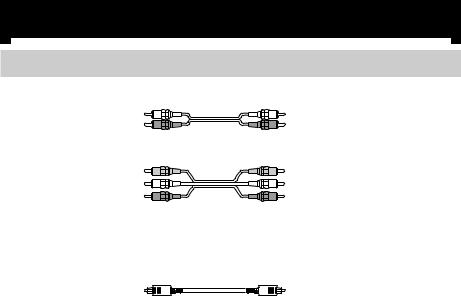
Hooking Up the Components
Required cords
AAudio cord (not supplied)
White (L) |
White (L) |
Red (R) |
Red (R) |
BAudio/video cord (not supplied)
Yellow (video) |
Yellow (video) |
White (L/audio) |
White (L/audio) |
Red (R/audio) |
Red (R/audio) |
CVideo cord (not supplied)
Yellow (video) 
 Yellow (video)
Yellow (video)
DOptical digital cord (not supplied)
Black |
Black |
ECoaxial digital cord (not supplied)
Orange  Orange
Orange
FMonaural audio cord (not supplied)
Black 
 Black
Black
Before you get started
•Turn off the power to all components before making any connections.
•Do not connect the AC power cord until all of the connections are completed.
•Be sure to make connections firmly to avoid hum and noise.
•When connecting an audio/video cord, be sure to match the color-coded pins to the appropriate jacks on the components: yellow (video) to yellow; white (left, audio) to white; and red (right, audio) to red.
•When you connect optical digital cords, insert the cord plugs straight in until they click into place.
•Do not bend or tie the optical digital cord.
6GB
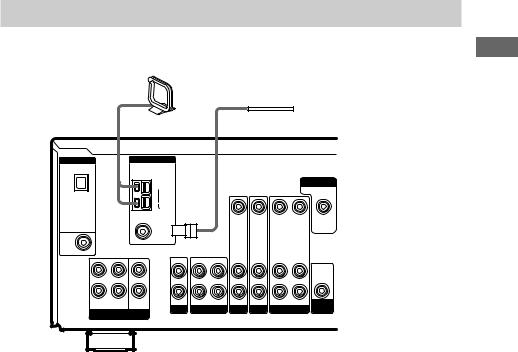
Antenna hookups
AM loop antenna (supplied)
FM wire antenna* (supplied)
DIGITAL |
ANTENNA |
|
|
|
|
|
|
|
|
OPTICAL |
|
|
|
|
|
|
|
|
|
VIDEO 2 |
AM |
|
|
|
|
|
|
MONITOR |
|
IN |
|
|
|
|
|
|
|||
|
|
|
|
|
|
|
|
|
|
|
|
|
|
|
VIDEO IN |
VIDEO IN |
VIDEO OUT |
VIDEO IN |
VIDEO OUT |
|
FM |
|
|
|
|
|
|
|
|
|
75Ω |
|
|
|
|
|
|
|
|
DVD/LD |
COAXIAL |
|
|
|
|
|
|
|
|
|
|
|
|
|
|
|
|
|
|
IN |
|
|
|
|
|
|
|
|
|
COAXIAL |
|
|
|
|
|
|
|
|
|
L |
|
|
|
|
|
|
|
|
AUDIO OUT |
|
L |
|
|
|
|
|
|
|
|
|
|
|
|
|
|
|
|
|
|
|
CENTER |
|
|
|
|
|
|
|
|
R |
R |
|
|
|
|
|
|
|
|
|
|
|
|
|
|
|
|
|
|
FRONT SURROUND |
SUB |
IN |
OUT |
IN |
AUDIO IN |
AUDIO IN |
AUDIO OUT |
AUDIO IN |
SUB |
WOOFER |
CD |
MD/TAPE |
DVD/LD VIDEO 2 |
VIDEO 1 |
|||||
|
|
WOOFER |
|||||||
MULTI CH IN
* The shape of the connector varies depending on the area code.
Notes on antenna hookups
•To prevent noise pickup, keep the AM loop antenna away from the receiver and other components.
•Be sure to fully extend the FM wire antenna.
•After connecting the FM wire antenna, keep it as horizontal as possible.
Up Hooking Components the
7GB
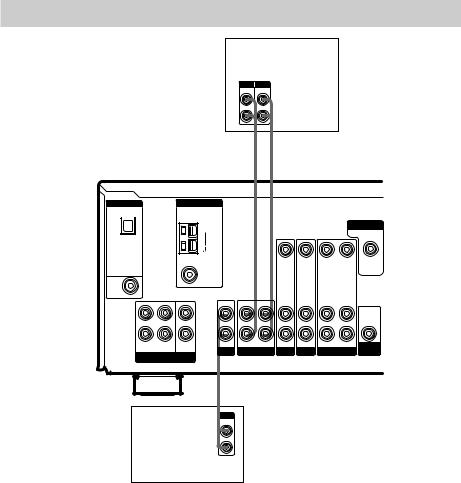
Audio component hookups
MD/Tape deck
INPUT OUTPUT
LINE LINE
L
R
AA
OUTç
ç
IN
DIGITAL |
ANTENNA |
OPTICAL |
|
IN |
|
|
|
|
|
|
MONITOR |
|
VIDEO 2 |
|
|
|
|
|
|
|
|
|
AM |
|
|
|
|
|
|
|
|
|
|
|
VIDEO IN |
VIDEO IN |
VIDEO OUT |
VIDEO IN |
VIDEO OUT |
|
FM |
|
|
|
|
|
|
|
|
75Ω |
|
|
|
|
|
|
|
DVD/LD |
COAXIAL |
|
|
|
|
|
|
|
|
|
|
|
|
|
|
|
|
IN |
|
|
|
|
|
|
|
|
COAXIAL |
|
|
|
|
|
|
|
|
L |
|
|
|
|
|
|
|
AUDIO OUT |
|
L |
|
|
|
|
|
|
|
|
|
|
|
|
|
|
|
|
CENTER |
|
|
|
|
|
|
|
|
R |
R |
|
|
|
|
|
|
|
|
|
|
|
|
|
|
|
|
SUB |
IN |
OUT |
IN |
AUDIO IN |
AUDIO IN |
AUDIO OUT |
AUDIO IN |
SUB |
FRONT SURROUND WOOFER |
CD |
MD/TAPE |
DVD/LD VIDEO 2 |
VIDEO 1 |
WOOFER |
|||
|
||||||||
MULTI CH IN
A
OUTPUT
LINE
L
R
CD player
8GB
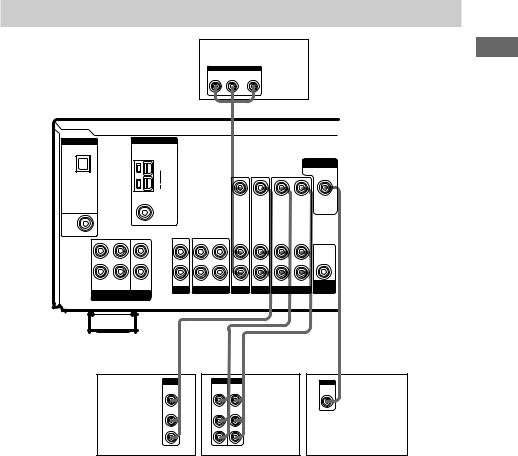
Video component hookups
|
|
|
|
DVD or LD player |
|
|||||
|
|
|
|
|
OUTPUT |
|
|
|
|
|
|
|
|
|
AUDIO OUT |
VIDEO |
|
|
|
||
|
|
|
|
R |
L |
|
OUT |
|
|
|
|
|
|
|
|
|
B |
|
|
|
|
DIGITAL |
ANTENNA |
|
|
|
|
|
|
|
|
|
OPTICAL |
|
|
|
|
|
|
|
|
|
|
VIDEO 2 |
AM |
|
|
|
|
|
|
|
MONITOR |
|
IN |
|
|
|
|
|
|
|
|||
|
|
|
|
|
|
|
|
|
|
|
|
|
|
|
|
|
VIDEO IN |
VIDEO IN |
VIDEO OUT |
VIDEO IN |
VIDEO OUT |
|
FM |
|
|
|
|
|
|
|
|
|
|
75Ω |
|
|
|
|
|
|
|
|
|
DVD/LD |
COAXIAL |
|
|
|
|
|
|
|
|
|
|
|
|
|
|
|
|
|
|
|
|
IN |
|
|
|
|
|
|
|
|
|
|
COAXIAL |
|
|
|
|
|
|
|
|
|
|
L |
|
|
|
|
|
|
|
|
|
AUDIO OUT |
|
L |
|
|
|
|
|
|
|
|
|
|
|
|
|
|
|
|
|
|
|
|
|
CENTER |
|
|
|
|
|
|
|
|
|
R |
R |
|
|
|
|
|
|
|
|
|
|
|
|
|
|
|
|
|
|
|
|
FRONT SURROUND |
SUB |
IN |
OUT |
IN |
|
AUDIO IN |
AUDIO IN |
AUDIO OUT |
AUDIO IN |
SUB |
WOOFER |
CD |
MD/TAPE |
DVD/LD VIDEO 2 |
VIDEO 1 |
||||||
|
|
WOOFER |
||||||||
MULTI CH IN
|
Ç |
IN |
OUT |
Ç |
|
Ç |
IN |
|
|
|
|
|
|||
|
B |
B |
|
B |
|||
|
OUTPUT |
INPUT OUTPUT |
|
|
|||
|
|
VIDEO |
VIDEO |
VIDEO |
|
|
|
TV tuner, |
|
OUT |
|
IN |
OUT |
|
|
|
|
|
|
|
|
|
|
satellite |
AUDIO |
AUDIO |
AUDIO |
|
|
||
|
OUT |
|
IN |
OUT |
|
|
|
tuner or |
|
L |
|
|
L |
|
|
|
|
|
|
|
|
VCR |
|
VCR |
|
R |
|
|
R |
|
|
Note on video component hookups
You can connect your TV’s audio output jacks to the VIDEO 2 AUDIO IN jacks on the receiver and apply sound effects to the audio from the TV. In this case, do not connect the TV’s video output jack to the VIDEO 2 VIDEO IN jack on the receiver. If you are connecting a separate TV tuner (or satellite tuner), connect both the audio and video output jacks to the receiver as shown above.
C
INPUT
VIDEO
IN
TV monitor
Up Hooking Components the
9GB
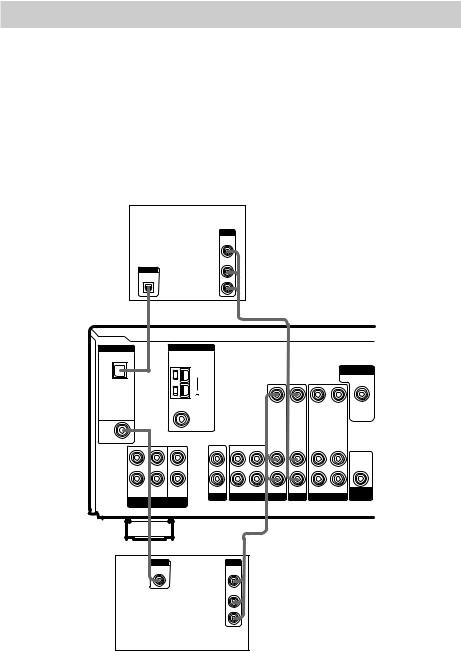
Digital component hookups
Connect the digital output jacks of your DVD player and satellite tuner (etc.) to the receiver’s digital input jacks to bring the multi channel surround sound of a movie theater into your home. To fully enjoy multi channel surround sound, five speakers (two front speakers, two surround speakers, and a center speaker) and a sub woofer are required. You can also connect an LD player with an RF OUT jack via an RF demodulator, like the Sony MOD-RF1 (not supplied).
Notes
•You cannot connect an LD player’s DOLBY DIGITAL RF OUT jack directly to this unit’s digital input jacks. You must first convert the RF signal to either an optical or coaxial digital signal. For details, see “Troubleshooting” on page 49.
•All the OPTICAL and COAXIAL jacks are compatible with 96 kHz, 48 kHz, 44.1 kHz and 32 kHz sampling frequencies.
TV tuner, satellite tuner or DVD player*
OUTPUT
VIDEO
OUT
AUDIO
OUT
OUTPUT |
L |
DIGITAL
OPTICAL
R
DB
DIGITAL |
ANTENNA |
|
|
|
|
|
|
|
|
OPTICAL |
|
|
|
|
|
|
|
|
|
VIDEO 2 |
AM |
|
|
|
|
|
|
MONITOR |
|
IN |
|
|
|
|
|
|
|||
|
|
|
|
|
|
|
|
|
|
|
|
|
|
|
VIDEO IN |
VIDEO IN |
VIDEO OUT |
VIDEO IN |
VIDEO OUT |
|
FM |
|
|
|
|
|
|
|
|
|
75Ω |
|
|
|
|
|
|
|
|
DVD/LD |
COAXIAL |
|
|
|
|
|
|
|
|
|
|
|
|
|
|
|
|
|
|
IN |
|
|
|
|
|
|
|
|
|
COAXIAL |
|
|
|
|
|
|
|
|
|
L |
|
|
|
|
|
|
|
|
AUDIO OUT |
|
L |
|
|
|
|
|
|
|
|
|
|
|
|
|
|
|
|
|
|
|
CENTER |
|
|
|
|
|
|
|
|
R |
R |
|
|
|
|
|
|
|
|
|
|
|
|
|
|
|
|
|
|
FRONT SURROUND |
SUB |
IN |
OUT |
IN |
AUDIO IN |
AUDIO IN |
AUDIO OUT |
AUDIO IN |
SUB |
WOOFER |
CD |
MD/TAPE |
DVD/LD VIDEO 2 |
VIDEO 1 |
|||||
|
|
WOOFER |
|||||||
MULTI CH IN
EB
OUTPUT |
OUTPUT |
DIGITAL |
VIDEO |
COAXIAL |
OUT |
|
AUDIO |
|
OUT |
DVD or LD player (etc.)*
L
R
*Make either coaxial or optical connections. We recommend making coaxial connections instead of optical connections.
10GB
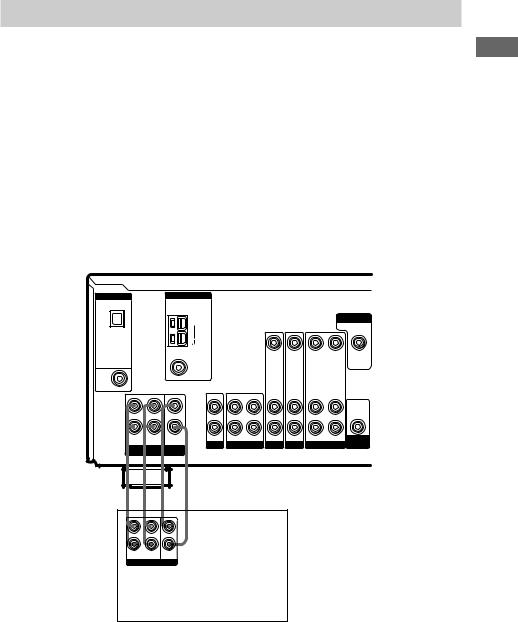
Multi channel input hookups
STR-DE585 and STR-DE485 only
Although this receiver incorporates a multi channel decoder, it is also equipped with multi channel input jacks. These connections allow you to enjoy multi channel software encoded in formats other than Dolby Digital and DTS. If your DVD player is equipped with multi channel output jacks, you can connect them directly to the receiver to enjoy the sound of the DVD player’s multi channel decoder. Alternatively, the multi channel input jacks can be used to connect an external multi channel decoder.
To fully enjoy multi channel surround sound, five speakers (two front speakers, two surround speakers, and a center speaker) and a sub woofer are required. Refer to the operating instructions supplied with your DVD player, multi channel decoder, etc., for details on the multi channel hookups.
Notes
•When using the connections described below, adjust the level of the surround speakers and sub woofer from the DVD player or multi channel decoder.
•See page 13 for details on speaker system hookup.
Up Hooking Components the
DIGITAL |
ANTENNA |
|
|
|
|
|
|
|
|
OPTICAL |
|
|
|
|
|
|
|
|
|
VIDEO 2 |
AM |
|
|
|
|
|
|
MONITOR |
|
IN |
|
|
|
|
|
|
|||
|
|
|
|
|
|
|
|
|
|
|
|
|
|
|
VIDEO IN |
VIDEO IN |
VIDEO OUT |
VIDEO IN |
VIDEO OUT |
|
FM |
|
|
|
|
|
|
|
|
|
75Ω |
|
|
|
|
|
|
|
|
DVD/LD |
COAXIAL |
|
|
|
|
|
|
|
|
|
|
|
|
|
|
|
|
|
|
IN |
|
|
|
|
|
|
|
|
|
COAXIAL |
|
|
|
|
|
|
|
|
|
L |
|
|
|
|
|
|
|
|
AUDIO OUT |
|
L |
|
|
|
|
|
|
|
|
|
|
|
|
|
|
|
|
|
|
|
CENTER |
|
|
|
|
|
|
|
|
R |
R |
|
|
|
|
|
|
|
|
|
|
|
|
|
|
|
|
|
|
FRONT SURROUND |
SUB |
IN |
OUT |
IN |
AUDIO IN |
AUDIO IN |
AUDIO OUT |
AUDIO IN |
SUB |
WOOFER |
CD |
MD/TAPE |
DVD/LD VIDEO 2 |
VIDEO 1 |
|||||
MULTI CH IN |
WOOFER |
||||||||
|
|
|
|
|
|
|
|
||
A A F F
L
CENTER
R
SUB
FRONT SURROUND WOOFER
MULTI CH OUT
DVD player,
Multichannel decoder, etc.
11GB
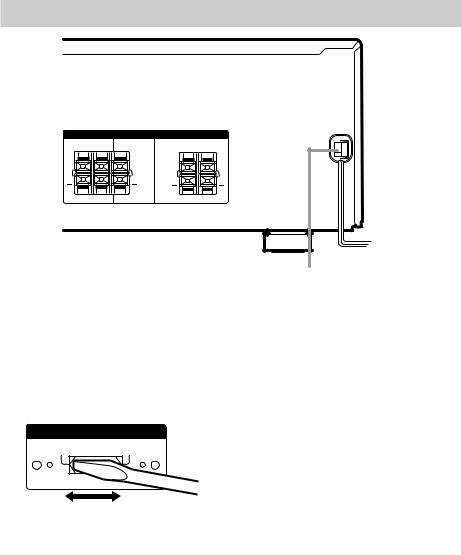
Other hookups
SPEAKERS IMPEDANCE USE 8 – 16Ω
SURROUND |
CENTER |
|
FRONT |
|
R |
L |
|
R |
L |
R |
L |
|
R |
L |
Setting the voltage selector
If your receiver has a voltage selector on the rear panel, check that the voltage selector is set to the local power supply voltage. If not, use a screwdriver to set the selector to the correct position before connecting the AC power cord to a wall outlet.
VOLTAGE SELECTOR
120V |
240V |
220V |
 b
b
To a wall outlet
AC power cord
Connecting the AC power cord
Before connecting the AC power cord of this receiver to a wall outlet, connect the speaker system to the receiver (page 13).
Connect the AC power cord(s) of your audio/ video components to a wall outlet.
12GB

Hooking Up and Setting Up the Speaker System
Speaker system hookups
Required cords
ASpeaker cords (not supplied)
(+) |
(+) |
(–) |
(–) |
BMonaural audio cord (not supplied)
Black 
 Black
Black
Active sub woofer |
Front speaker |
Front speaker |
||
|
|
(R) |
|
(L) |
INPUT |
|
|
|
|
AUDIO |
E |
e |
|
e |
IN |
E |
|||
|
||||
B |
|
A |
|
A |
MONITOR
VIDEO OUT
SPEAKERS IMPEDANCE USE 8 – 16Ω
SURROUND |
CENTER |
|
FRONT |
|
R |
L |
|
R |
L |
AUDIO OUT |
|
|
|
R |
L |
R |
L |
SUB |
|
|
|
WOOFER |
|
|
|
Up Hooking
Setting and the Up System Speaker
A A A
E 
e
E |
Ee |
e |
Surround speaker Surround speaker Center speaker
(R)(L)
continued
13GB
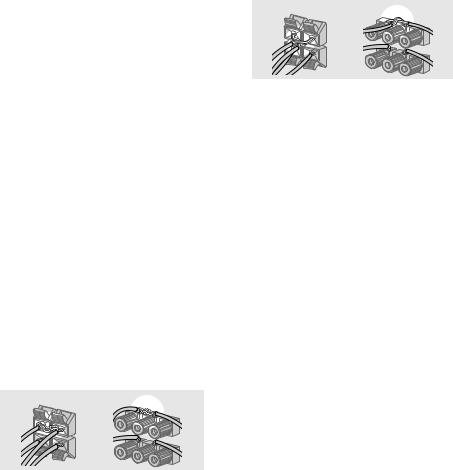
Speaker system hookup (continued)
Notes
•Twist the stripped ends of the speaker cords about 10 mm (2/3 inch). Be sure to match the speaker cord to the appropriate terminal on the components: + to + and – to –. If the cords are reversed, the sound will be distorted and will lack bass.
•If you use speakers with low maximum input rating, adjust the volume carefully to avoid excessive output on the speakers.
To avoid short-circuiting the speakers
Short-circuiting of the speakers may damage the receiver. To prevent this, make sure to take the following precautions when connecting the speakers.
Make sure the stripped ends of each speaker cord does not touch another speaker terminal, the stripped end of another speaker cord, or the metal parts of the receiver.
Examples of poor conditions of the speaker cord
Stripped speaker cord is touching another speaker terminal.
Stripped cords are touching each other due to excessive removal of insulation.
After connecting all the components, speakers, and AC power cord, output a test tone to check that all the speakers are connected correctly. For details on outputting a test tone, see page 20.
If no sound is heard from a speaker while outputting a test tone or a test tone is output from a speaker other than the one whose name is currently displayed on the receiver, the speaker may be short-circuited. If this happens, check the speaker connection again.
To avoid damaging your speakers
Make sure that you turn down the volume before you turn off the receiver. When you turn on the receiver, the volume remains at the level you turn off the receiver.
14GB
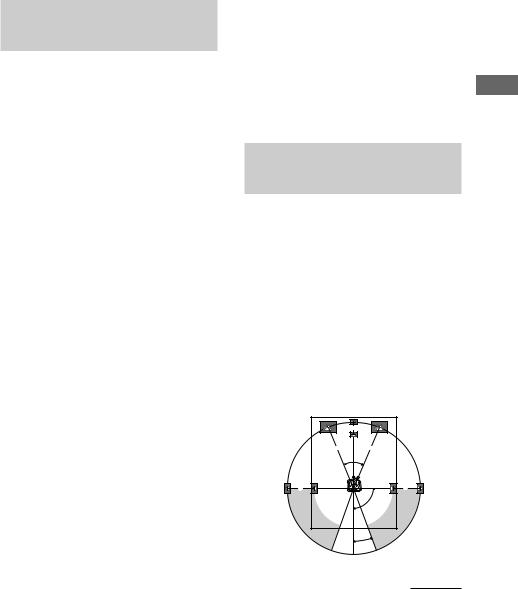
Performing initial setup
operations
Once you have hooked up the speakers and turned on the power, clear the receiver’s memory. Then specify the speaker parameters (size, position, etc.) and perform any other initial setup operations necessary for your system.
Tip
To check the audio output during settings (to set up while outputting the sound), check the connection (page 20).
Clearing the receiver’s memory
Before using your receiver for the first time, or when you want to clear the receiver’s memory, do the following.
This procedure is not necessary if the demonstration activates when you turn on the power.
1 Turn off the receiver.
2 Hold down ?/1 for 5 seconds.
The demonstration starts (page 4) and all of the following items are reset or cleared:
•All preset stations are reset or cleared.
•All sound field parameters are reset to their factory settings.
•All index names (of preset stations and program sources) are cleared.
•All SET UP parameters are reset to their factory settings.
•The sound field memorized for each program source and preset stations are cleared.
•The master volume is set to VOL MIN.
Performing initial setup operations
Before using your receiver for the first time, adjust SET UP parameters so that the receiver correspond to your system. For the adjustable parameters, see the table on page 54. See pages 16–20 for speaker settings and pages 36-37 for other settings.
Multi channel surround
setup
For the best possible surround sound, all speakers should be the same distance from the listening position (A).
However, the receiver lets you place the center speaker up to 1.5 meters (5 feet) closer (B) and the surround speakers up to 4.5 meters (15 feet) closer (C) to the listening position.
The front speakers can be placed from 1.0 to 12.0 meters (3 to 40 feet) from the listening position (A).
You can place the surround speakers either behind you or to the side, depending on the shape of your room (etc.).
When placing surround speakers to your side
B |
A A
45°
C |
C |
90°
20°
continued
Up Hooking
Setting and the Up System Speaker
15GB
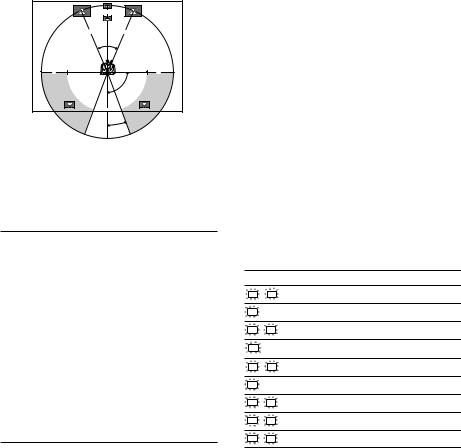
Multi channel surround setup (continued)
When placing surround speakers behind you
B |
A A
45°
C |
C |
90°
20°
Note
Do not place the center speaker farther away from the listening position than the front speakers.
Normal Speaker and Micro
Satellite Speaker
If you are using |
Select |
Normal Speakers |
NORM. SP. |
|
|
Micro Satellite Speakers |
MICRO SP. |
|
|
The speaker size and the sub woofer selection has been preset to NORM. SP. You can adjust the speaker size and sub woofer selection when you select NORM. SP. (pages 17-18)
To select MICRO SP., turn off the power, then turn on again while pressing LEVEL. (To reset to NORM. SP., do the same procedure.)
When you select MICRO SP., the speaker size and sub woofer selection has been configurated as follows:
Speaker |
Settings |
FRONT |
SMALL |
|
|
CENTER |
SMALL |
|
|
SURROUND |
SMALL |
|
|
SUB WOOFER |
YES |
|
|
You cannot change the configuration if you select MICRO SP.
Tip
The setting for Micro Satellite Speaker (MICRO SP.) has been programmed to optimize the sound balance. If you use Sony’s Micro Satellite Speakers, select MICRO SP.
Caution
When you use Micro Satellite Speakers and the speaker size is set to “LARGE”, you may not obtain the correct soundstage. The speaker may also be damaged at high volume position.
Specifying the speaker parameters
1 Press SET UP.
2 Press MENU  or MENU
or MENU  to select the parameter you want to adjust.
to select the parameter you want to adjust.
3 Press MENU + or MENU – to select the setting you want.
The setting is entered automatically.
4 Repeat steps 2 and 3 until you have set all of the parameters that follow.
Initial settings
Parameter |
Initial setting |
||
L |
R |
(FRONT) |
LARGE* |
C |
(CENTER) |
LARGE* |
|
SL |
SR |
(SURROUND) |
LARGE* |
SW (SUB WOOFER) S.W. XXX |
YES* |
||
L |
R DIST. XX.X m (ft.)** |
5.0 m (16 ft.)** |
|
C DIST. XX.X m (ft.)** |
5.0 m (16 ft.)** |
||
SL |
SR DIST. XX.X m (ft.)** |
3.5 m (11 ft.)** |
|
SL |
SR |
PL. XXX |
BEHD. |
SL |
SR |
HGT. XXX |
LOW |
*You can set this parameter only when you select NORM. SP.
**Models of area code U, CA only.
16GB
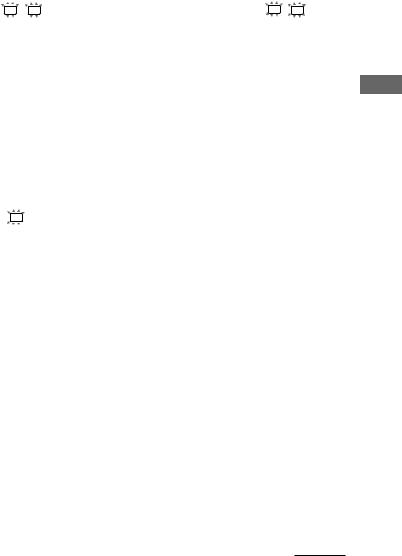
x Front speaker size ( L
L 
 R
R  )
)
•If you connect large speakers that will effectively reproduce bass frequencies, select “LARGE”. Normally, select “LARGE”.
•If the sound is distorted, or you feel a lack of surround effects when using multi channel surround sound, select “SMALL” to activate the bass redirection circuitry and output the front channel bass frequencies from the sub woofer.
•When the front speakers are set to “SMALL”, the center and surround speakers are also automatically set to “SMALL” (unless previously set to “NO”).
x Center speaker size ( C
C  )
)
•If you connect a large speaker that will effectively reproduce bass frequencies, select “LARGE”. Normally, select “LARGE”. However, if the front speakers are set to “SMALL”, you cannot set the center speaker to “LARGE”.
•If the sound is distorted, or you feel a lack of surround effects when using multi channel surround sound, select “SMALL” to activate the bass redirection circuitry and output the center channel bass frequencies from the front speakers (if set to “LARGE”) or sub woofer.*1
•If you do not connect a center speaker, select “NO”. The sound of the center channel will be output from the front speakers.*2
x Surround speaker size ( SL
SL
 SR
SR )
)
•If you connect large speakers that will effectively reproduce bass frequencies, select “LARGE”. Normally, select “LARGE”. However, if the front speakers are set to “SMALL”, you cannot set the surround speakers to “LARGE”.
•If the sound is distorted, or you feel a lack of surround effects when using multi channel surround sound, select “SMALL” to activate the bass redirection circuitry and output the surround channel bass frequencies from the sub woofer or other “LARGE” speakers.
•If you do not connect surround speakers, select “NO”.*3
Tip
*1–*3 correspond to the following Dolby Pro Logic modes
*1 NORMAL
*2 PHANTOM
*3 3 STEREO
Tip
Internally, the LARGE and SMALL settings for each speaker determine whether the internal sound processor will cut the bass signal from that channel. When the bass is cut from a channel, the bass redirection circuitry sends the corresponding bass frequencies to the sub woofer or other “LARGE” speakers.
However, since bass sounds have a certain amount of directionality, it is best not to cut them, if possible. Therefore, even when using small speakers, you can set them to “LARGE” if you want to output the bass frequencies from that speaker. On the other hand, if you are using a large speaker, but prefer not to have bass frequencies output from that speaker, set it to “SMALL”.
If the overall sound level is lower than you prefer, set all speakers to “LARGE”. If there is not enough bass, you can use the BASS +/– to boost the bass levels. To adjust the bass, see page 29.
continued
Up Hooking
Setting and the Up System Speaker
17GB
